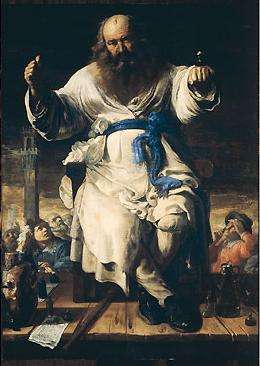Bernardino Mei
The Italian painter and engraver Bernardino Mei (1612/15 – 1676) worked in a Baroque manner in his native Siena and in Rome, finding patronage above all in the Chigi family.[1]
_-_Christ_Cleansing_the_Temple_-_Google_Art_Project.jpg)

Briefly a pupil of the Sienese cartographer and draughtsman Giuliano Periccioli, where he learned the art of engraving, Bernardino passed to the studio of the painter Rutilio Manetti and probably also served in the workshop of Francesco Rustici.[2]
He painted in and around Siena, where his work came to the attention of Cardinal Fabio Chigi, who, once elected pope as Alexander VII (1655), called Bernardino Mei to Rome in 1657. There Bernardino came under the influences of Mattia Preti,[3] Andrea Sacchi and Pier Francesco Mola, and of Guercino, to the extent that until the 20th century Bernardino's fresco of Aurora in Palazzo Bianchi Bandinelli was attributed to Guercino himself. Through the fast friendship that bonded him to Gian Lorenzo Bernini, whose studio he frequented, he applied that sculptor's sense of theatrical action to his own mythological and allegorical subjects. He died in Rome in 1676.

In the 19th century, Bernardino was dismissed as a tame follower of greater lights,[4] but his painting was re-evalued in the later 20th century,[5] expressed in the exhibition Bernardino Mei e la pittura barocca a Siena, Siena, 1987.
Notes
| Wikimedia Commons has media related to Bernardino Mei. |
- Bernardino's Faith and Hope and later works Bathsheba and The Judgement of Solomon are among his works that remain in Palazzo Chigi-Saracini, via della Città, Siena (Gloria Fossi, Siena segreta. La collezione Chigi Saracini e i musei nascosti 1988:xix.
- Giovanni Rosini, Storia della pittura italiana; Luigi Lanzi was unwilling to hasard a guess as to Bernardino's early master (Lanzi, Storia pittorica dell'Italia dal risorgimento delle belle arti fin presso al fine del XVIII secolo, p. 363).
- Enzo Carli (Sienese Painting, 1983:78) points out, in connection with Bernardino's "echoes of Mattia Preti", the fact that Preti executed some commissions in Siena.
- "Non ebbe stile proprio ma prendeva, secondo il suo capriccio a imitare or Paolo [Veronese], ora i Carracci, ora il Guercino" (Rosini)
- He is still "a second-rate Sienese painter" in Francis Haskell, Patrons and Painters, 1980:154.